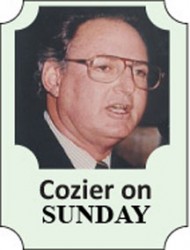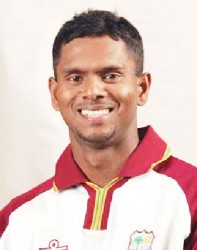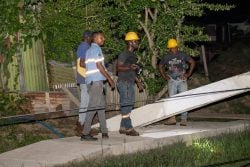WHEN the Frank Worrell Trophy was last contested, in the Caribbean in 2012, Michael Clarke, with praise rare from an Australian captain, credited West Indies with waging a “really hard-fought” series, adding that he hoped they “get a lot of credit for the way they played”.
Australia prevailed in two of the three Tests; the weather precluded a result in the other. That West Indies carried each match into the fifth day was something of an accomplishment for a team that had spectacularly plummeted down the rankings after Mark Taylor’s Australians ended their 15 years of Test cricket supremacy with a 2-1 triumph before their stunned devotees in 1995.
A split of the ODIs and the two T20s lent credibility to Clarke’s comment and to coach Mickey Arthur’s “they went toe-to-toe with us”.
 The outcome hinted at an overdue revival for West Indies as much as it did a waning of Australia’s strength.
The outcome hinted at an overdue revival for West Indies as much as it did a waning of Australia’s strength.
West Indian optimism proved fleeting; the results soon reverted to type. After a few difficult years, Australia rebounded to rise to No.2 on the ICC’s Test rankings and to reclaim the World Cup they had surrendered in 2011.
Three months after Clarke’s team departed, New Zealand arrived in the Caribbean to be beaten in both Tests, four of the five ODIs and both T20s. Such emphatic domination proved an illusion.
Over the past year and a half, they have suffered reversals against the Black Caps, both in New Zealand and West Indies, as well as heavy defeats in the Tendulkar Farewell Tests in India and most recently in South Africa. Their only successes were over Bangladesh (twice) and Zimbabwe.
A youth-based 1-1 result at home under a new coach less than a month ago against England, No.3 on the ICC’s register, raises expectations, for the umpteenth time, of a better future.

Australia, revitalized by the typically upbeat attitude of their own new coach, the fair dinkum Aussie, Darren Lehmann, have returned to the region for two Tests, compressed into a period of 12 days, the first starting June 3 at Windsor Park in Dominica, the second eight days later at Sabina Park in Jamaica.
Given the statistical disparity between the teams, the mini-series is considered relaxing preparation for the Australians, still skippered by Clarke, prior to the real business of defending the Ashes in England that immediately follows.
It is an opportunity, so the reasoning goes, for their key players to become reacquainted with the long format after four months confined to the artificial limitations of the World Cup and the Indian Premier League (IPL).
In such a scenario, West Indies’ only option would be damage limitation; it is not quite as straightforward as that.
Both Clarke and his West Indian counterpart Denesh Ramdin lead teams reconstituted since their 2012 series.

Ricky Ponting and Michael Hussey ended their illustrious careers less than a year later; Clarke himself and Steve Smith have capably filled the batting void in the interim. Smith, whose initiation it is into the complexities of West Indies cricket, brings a notable record with him; eight hundreds in 15 Tests since Ponting and Hussey departed.
The belligerent left-handed opener, David Warner, endured a modest return three years ago, averaging 28.5; he is back with an average of 48.2, 12 hundreds in his 36 Tests and unchanged aggression against all bowling .
The two Mitchells, Johnson and Starc, both left-arm over the wicket and distinctly hostile, Peter Siddle and the strapping 24-year-old Josh Hazlewood are as intimidating as any current Test attack; Johnson missed the previous tour through injury, Siddle and Starc had one match each, Hazlewood was a promising 20-year-old a year and half off his debut Test.

It is a combination that has generated a hat-trick of successes over the past year and a half (a 5-0 Ashes whitewash over England at home, 2-1 over South Africa in the Clash of the Titans in South Africa a month later and 2-0 over India in four Tests in Australia last December and January, along with the subsequent repossession of the World Cup).
For all that, Clarke is openly wary of underestimating opponents who he expects “to prove a handful”. The conditions are likely to be “very similar to the subcontinent so I think the wickets will be slow and low and will spin.”
He should know from personal experience; in a rare trundle of his left-arm spin in the Dominica Test last time, he claimed five for 86 from 23 overs. Nathan Lyon, the off-spinner, was then their leading wicket-taker; West Indies’ off-spinner Shane Shillingford had five wickets in each innings in his native Dominica, earning him the title sporting ambassador and a diplomatic passport from a proud government.
Lyon is back as Australia’s established spinner, Shillingford’s suspensions for a bent-elbowed action have effectively ended his Test prospects.
Clarke’s caution is based on Australia’s problems away from the comforts of home in recent times.
“Travelling overseas is a tough part of playing international cricket,” he said before setting off for Antigua where the Australians start their only warm-up match on Wednesday against West Indies’ next-in-line contenders playing under the banner of the President’s XI. “To be able to win away from home is the challenge we face in the West Indies.”
In 2013, they were thrashed in all four Tests in India, 3-0 in the Ashes in England and held 1-1 by Pakistan in the UAE; last year, they lost 2-1 in South Africa and 2-0 (by 221 runs and 356 runs) to Pakistan in the UAE.
Only strong performances in the forthcoming Tests in the Caribbean and in the subsequent Ashes in England would authenticate their claims to be international cricket’s most powerful contemporary team.
West Indies’ ambitions extend no further than continuing the progress sustained against England.
Like the young Australians with Lehmann, the rising generation now comprising almost half the squad – the batsmen Darren Bravo, Kraigg Brathwaite, Jermaine Blackwood and the all-rounder Jason Holder, the fast bowler Shannon Gabriel – appeared to respond positively to Phil Simmons in his first series as head coach.
The inevitable decline, at 40, of the ever dependable Shivnarine Chanderpaul, repeated saviour of lost causes throughout his 21 years in the West Indies middle order, left the batting in the care of those in their low and mid 20s; the experience of Marlon Samuels, the only other over 30 in the top six, became essential.
With a dearth of quality spinners, Jerome Taylor returned after a lengthy absence to spearhead the bowling against England. He and Kemar Roach, the standout fast bowler on either side in 2012 with 19 wickets at 19.73 runs each, would comprise an incisive new ball combination against the Aussies once Roach rediscovers the form that deserted him after shoulder and ankle injuries.
The mood of West Indies was evident as much in the standard of the fielding against England as the batting and bowling.
There were 19 catches, 11 between first slip and gully, in addition to keeper Ramdin’s six and two stumpings. These were complemented by five slick run outs.
Bravo, an unreliable fielder in the deep during the 2012 series, has morphed into a slip catcher with Teflon hands; five of his six were snared at first slip.
Only two were missed, both at slip by Devon Smith late on the final day of the Grenada Test when England’s victory was assured and thoughts of his tenuous place in the team was a distraction; a year ago, six were spilled in the space of two sessions on the fourth afternoon of the first Test against Bangladesh, another eight in the three Tests against New Zealand.
Simmons was suitably encouraged yet, after eight years in the same position with Ireland, the strongest of the ICC associates, he is aware of the perils of expecting too much, too soon.
The Australians present as daunting an examination of his team’s resilience as could be expected this early in his tenure. He will know more about his emerging team once it’s over.



